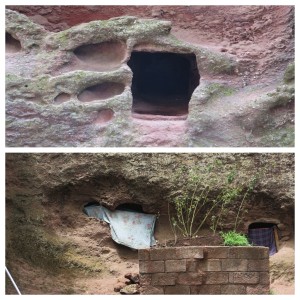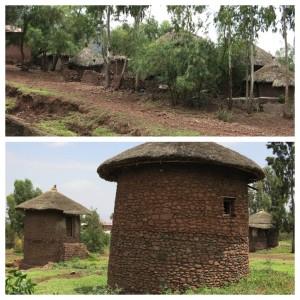Our Ethiopian History Lesson
by Noelle
June 17 – 19
Before we get to the aforementioned scarring experience, first we learn our history. Now THIS is what you expect from one of the oldest countries in Africa – churches, castles, tales of terrible Emperors and pious heroes. Lalibela, where 11 monolithic rock-hewn churches rule the main area of town, and Gondar, nicknamed “The Camelot of Africa” due to the group of royal castles, were both incredibly cool places to see firsthand.
Our adventure started in Lalibela, a quick flight from Addis, where our arrival was the sole plane at the airport. Coming from our main references – O’Hare, LA and NYC’s airports – this struck us as hilarious. Boarding is a free for all, with everyone literally pushing to get to the plane first (first come, first served, Southwest Airlines-style). As you may imagine, this is where my competitive side kicks in, and Dave has to hold me back from smack talking the businessman who PUSHED (!) me aside at the front of the line.
Lalibela’s rock-hewn churches were built 900 years ago, and have been the destination of hundreds of thousands of pilgrims. Each is home to a holy, hand-held bronze cross, displayed upon request. The services to this day continue for hours. The priests beat drums, rattle sistrums, dance and sing, so perhaps the time passes quickly? If not, there are crutch-like poles, which we were told (in whispered confidence) are at times used for short naps.
It’s mind-blowing to picture the architects and builders of that time creating these structures from ONE ROCK. Think about it – they used chisels, hammers and ancient levels to carve DOWN into the earth, creating these masterpieces. It’s such an incredible feat for a country that STILL doesn’t have safe drinking water or any sort of modern developments. Our favorite was the church dedicated to Ethiopia’s patron saint, Saint George. It is visually stunning, especially from above – a Greek cross dug in a deep square pit. As it happens, we’ve become well acquainted with World Heritage sites in the past few months, and these churches quickly jumped to the top of that list of UNESCO sites. The relatively unattractive protective roofs, while doing wonders for the preservation of the buildings, detract from the natural state of the churches.

A hole once used as a tomb in the walls beside the church (top), pilgrims taking residence in the former tombs for prayer and meditation…no thanks (bottom)
Lunch brought us our first encounter with authentic Ethiopian food, mainly revolving around injera, a starchy-flat-almost-soggy bread substitute that is used in place of silverware, to soak up the array of sauces, spicy spreads, vegetables and diced meat. Eating the spread with your hands can only be described as fulfilling the desire of the 10-year-old inside of us. OH – and it’s freaking delicious.
Back to the tour, our guide, a friend of Chris and Lindsay (the U.S. friends we stayed with in Addis, for those who aren’t reading all our posts. Btw, WHAT ARE YOU THINKING?? Hmmmmmm?), was the MAN. Born in Lalibela, Belay was an incredible resource on the history of his hometown. We were happy to have had such a kind, passionate guide as we toured the dusty roads. Although tourism is a rapidly growing industry there, we were – along with the two other Americans who came with us from Addis – the ONLY non-Ethiopians we saw during our stay.
Along the way, Belay shared that with over 17,000 people living in Lalibela, he found it surprising there wasn’t more passion around furthering technology and development. In agreement with his assessment, we were taken by the juxtaposition of impoverished, cloth-clad locals and their fellow pedestrians wearing graphic tees and collard shirts. It was confusing, and made me wonder how much of the simply-built homes and dusty, barely-driveable roads were by choice as opposed to forced circumstances.
Our hotel was definitely made for visitors to the city, with hot showers and killer views from each balcony. Our dinner pick was something out of a Dr. Suess book as the four of us visited the Scottish-chef-owned restaurant overlooking the mountains in every direction. We enjoyed a few of the local St. George beers (tasty, light brews) and the African sunset, feeling relatively at home in a city so out of our element.
On to Gondar.
As we exited the airport after our 30-minute flight, we followed the man holding a sign with our names, assuming he was the guide we were expecting. After asking him to confirm, he responded with silence. While disconcerting, we climbed in his car because WHAT ELSE ARE YOU GOING TO DO, YOU’RE IN THE MIDDLE OF AFRICA. (sorry, mom.) Turns out, it was the right taxi guy, just limited English. We met our guide upon arrival at the hotel. Crisis averted.
We once again felt like the odd men man and woman out in Gondar (even losing our other twosome as they ventured into the hills of Lalibela for some hiking), and as we made our way to our hotel (again, a comfy accommodation arranged by our U.S. friends), we realized what a rare feeling it was for both of us. Even with many international travels between us, we were used to being surrounded by other tourists, but here, we were stared at (in the better moments, called at in others) as we ventured out to wander the city on our own. Once. It was that awkward.
Our local guide, Tamirat, was another passionate, intelligent and funny resource, with a masters in Tourism. He took us first to Selassie Church (me entering from a separate door for women). Asking us to lay on the ground (But Tamirat, we just met….), he had us stare at the ceiling paintings of the angels, just as original worshipers had done for inspiration. The walls were covered with stories from the bible, and as he took us through each one, they came to life, and you could see how large a part religion played in Gondar. After asking about his personal religion, Tamirat shared that he had left the Orthodox Christian church shortly after his studies as he pursued the Protestant faith. His mother kicked him out, only forgiving him recently and welcoming him back home (blood seems to trump religion with moms every time). Note it is also common for children to live with their parents well into middle age, if not permanently. With the funky way land-ownership works there, it may be that they are unable to get their own space, so families tend to live on top of one another (EDITOR’S NOTE: I wish I’d known of this story to use as my excuse for moving home after college. That was totally why I did it…).
Next (via sexy Tuk-Tuk), we visited the ruins of a few 17th and 18th century castles, beautiful, crumbling structures, not showing a drop of the influence the Italian occupation of the late 1930s left on the downtown neighborhood. A cool contrast. And another incredible day in a city we had never even HEARD of before this trip. This was a moment which, despite being a bit uncomfortable, had proven to be one of the experiences we had most looked forward to as we began our adventure. So few people had seen what we were witnessing – giving you a quick punch to the gut of realization about how small a part of the world you really are.

Upon seeing this castle, I declared I wanted to live there. It was followed by thoughts of me letting down my hair for Dave to climb up, but I kept that part to myself.

Crowds gather at my house, er, the Fasilides’ Bath in Gondar to celebrate Timkat – the Epiphany for the Ethiopian Orthodox Church each January. This entire area is filled with water, a priest releases a candle afloat and after the blessing is said, all attendees strip down and jump in – it’s said the first to reach the candle will receive many blessings. Keep your calendars clear for January 2014.

And again – THE FOOD. We had a seriously amazing dining experience at Four Sisters, a joint run by (surprise) 4 sisters, where incense and live music assault the senses as you enter. (EDITOR’S NOTE: The music Noelle refers to only started after a man at the front gate of the restaurant blew what we eventually referred to as the “tourist horn” to alert the musician to start playing as we approached the door… so there was that.) Before the meal even begins, they bring around roasted coffee beans by the table to entice your sense of smell, before you devour in a HUGE “Fasting Plate” which consists of the spreads and vegetables I mentioned earlier, and enough injera to sop it all up. A side of Tibs (be it beef, lamb, etc) to roll into each bite put us in a food coma. Finishing the meal with rich, Ethiopian coffee made us happy people.
On full stomachs, we returned to the hotel and slept happily ever after.
NOT!
We happened to be in the city on St. Michael’s Day. Which means they chant and play music throughout the city all night long, ALLNIGHTLONG. (EDITOR’S NOTE: Shut the doors and windows you say? The 1-inch gap beneath the door and unsealed windows refused to make it that easy.) So after vowing to buy earplugs at the next possible moment, we tossed and turned and got a fitful night of sleep. Perhaps a foreboding sign of what was to come on our trek through the Simien Mountains starting the very next day…?

















